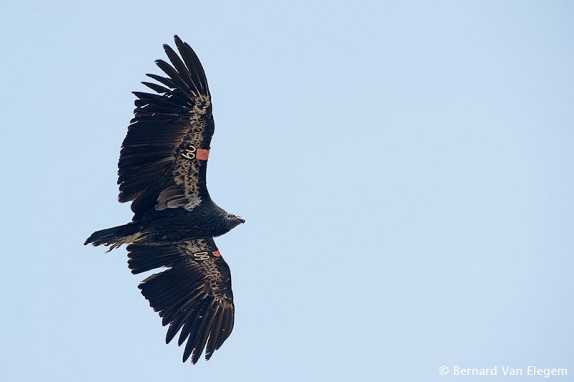- 1 of 74
- next
California Condor - Californische Condor - Gymnogyps californianus
Juvenile bird.
The California Condor is one of the most rare and threatened bird of prey in the world. The species is listed by IUCN as Critically Endangered.
The species once occupied the mountains of almost the entire Pacific coast of North America. During Pleistocene, when large prey roamed abundantly around the North American continent, and large carcasses were frequently encountered, the species was widespread across much of North America. It must have occupied a wide range of prairie, mountain and hillside habitats. During 19th century the species knew a dramatic decline and soon dissapeared from everywhere except California by middle to late 1930s. Even more important then the decline of (large) carcasses, the main causes of the decline were primarily due to persecution (shooting) and lead poisoning caused by accidental ingestion of lead fragments (from bullets) and lead shot (from carcasses). Additional causes of mortality included various type of poisoning and collision with power lines. The species became extinct in wild from 1987 to 1992. By 1981, numbers had fallen to all-time low of only 22 individuals, and two years later eggs were taken from nests for rearing in captivity; in 1987 last wild individual was taken in to join a captive breeding programme. Since then, the captive population was used for reintroduction to the species former range, first in the hills around San Joaquin Valley, California; followed by subsequent reintroductions in North Arizona and in the extreme North West of Mexico (N Baja California).
Despite relatively low genetic diversity (just three subgroups of birds and 27 individuals), the captive breeding programme was highly successful: the captive population rose up to 66 individuals by 1993. The first 8 young birds were released in 1992 in the wild. In 2002 the California Condor bred again in the wild, and by February 2009 a total of 56 breeding attempts had been recorded, and at least 19 chicks fledged and survived. By the end of 2006, 130 wild individuals were present at five release sites. At least 44 of these were more than six years old (earliest age at which species breeds), and in early 2012 totals of 213 individuals were counted in the wild (mainly in S & C California) and 173 in captivity. Although this evolution seems hopeful for the species, lead poisoning still seems an ongoing threat for released individuals. So the species is still highly dependent on the captive breeding and conservation programmes.
I was lucky to observe a group of 8 California Condors above the Grand Canyon.

